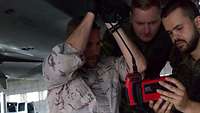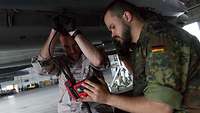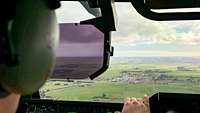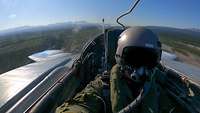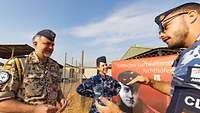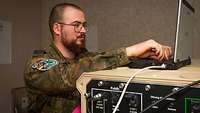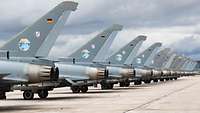Combined maintenance - the prime example of cooperation
Combined maintenance - the prime example of cooperation
- Date:
- Place:
- Alaska
- Reading time:
- 4 MIN
The combat aircraft were being prepared for their onward journey to Japan. But then an exciting telephone call was received. An engine of a Spanish aircraft was defective. During the Arctic Defender exercise, mechanics and technicians from both nations installed a German engine in a Spanish Eurofighter.
For many servicemen and women of the Maintenance Squadron and Technical Group, 31 Tactical Air Wing Boelcke, it was the first cooperation with Spanish soldiers. For them, it is something special: Combined maintenance. It is the joint technical work of the two Eurofighter nations. This joint technical work is, for example, practiced during air policing in the Baltic States or during exercises like Arctic Defender. The German and Spanish soldiers are tasked with exchanging procedures and supporting each other in order to conduct joint preparations and after-action activities on the Eurofighters for multinational exercises and operations. For this purpose, the maintenance and engineering personnel consisting of 50 Spanish and about 150 German soldiers are conducting day-to-day troubleshooting – depending on the malfunction. Since both nations use the same aircraft types, A400M and Eurofighter, an exchange of personnel and materiel is possible.
On 17 July 2024 at the end of Arctic Defender, all combat aircraft were prepared for the onward journey to Japan. – Due to the few alternate aerodromes available en route, it is one of the most critical sections of the entire Pacific Skies 24 deployment. On the evening before the departure, the call came: The engine of a Spanish aircraft is defective and the aircraft cannot deploy to Japan. At 04:30 am, the first phones in Germany started to ring because a solution was needed. The Air Force forces in Alaska, the Air Force Forces Command and the authorized representative for Eurofighter worked as quickly as possible across the different time zones. A packed engine for the German Eurofighters was planned to be transported to India. In a change of plan, it was quickly decided to use it for the Spanish aircraft. Both nations began to check at the same time whether the software of the engines was compatible. As with a computer, there may be differences and the software can be incompatible. Within four hours, all necessary approvals and test loops were completed and the German engine was officially released for use in the Spanish Eurofighter. In order to save time, the Spanish soldiers removed the engine from their aircraft in parallel with the arrangements. In record-breaking time, the soldiers of both nations managed to ensure the onward journey of the combat aircraft by installing the engine just as quickly.
Had the soldiers not cooperated successfully, two Spanish Eurofighters would still be in Alaska, although only one aircraft was damaged. This is due to the fact that Spanish aircraft always fly in a two-ship formation. Thus, several resources for the deployment to Australia via Japan would have been lost.
Challenges during the exercise
The language barriers alone can lead to difficulties when using technical jargon. However, it is a way to broaden one's knowledge or simply communicate with each other. And not only when it comes to language: A contract concluded in advance, a technical arrangement between the nations, basically regulates the exchange of very small components and oils in order to support each other if required. The installation of the German engine in a Spanish Eurofighter in a self-sufficient way is not covered by this contract between the two nations. The fact that the engine replacement was nevertheless successful is the result of the commitment and flexibility of the soldiers and of all personnel that carried out preparatory work from different time zones. This is exactly what the goal of the exercise is: To demonstrate flexibility and capabilities in a complex exercise.
The personnel
The two countries also support each other as regards personnel. However, there was no work overload caused by the additional aircraft. In urgent cases, the technical group commander decides to prioritize the work and thus avoids an additional burden on the personnel.
Exceptional cases like this engine replacement are rare but reinforce the cooperation, which will also continue in Australia and India as part of combined maintenance. According to General Frank Gräfe, it was a complete success: "This quick engine replacement by Spanish and German personnel was a prime example and the proof of our flexibility during such a challenging deployment. Many thanks to all those involved for the extremely fast work and excellent cooperation, the technicians from 31 Tactical Air Wing and, in particular the Air Force Forces Command and the authorized representative for Eurofighter, for the quick approval of the installation."


